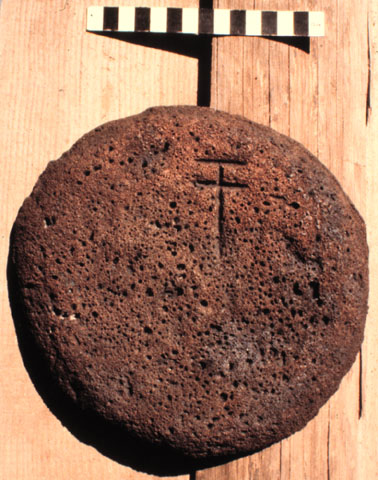
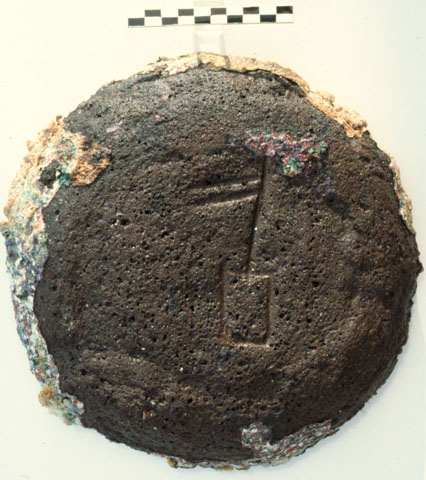
TOPIC III: Evidence for Pre-Lydian Coin and Currency (Last revised JULY 15, 2004 )
1. With respect to the origins of coinage, most scholars believe with Herodotus (1.93-94, 5.101) that it begins in Lydia in Asia Minor in the second half of the seventh century. The pioneering role of Lydia is attested in the sixth century BCE writer Xenophanes who is quoted in a thesaurus written in the second century CE by Pollux (9.83). The earliest surviving sealed precious metals universally accepted as coins date to the seventh century. There are, of course, Greek traditions placing coinage much earlier. Thus, Plutarch (Theseus 25.3) wrote in the first century CE that Theseus, legendary unifier and king of Attica, issued coins. Pollux (9.83), in the later second century CE, claimed that coinage was invented by the even more shadowy Athenian figure Erichthonius, an early king. Moving from legend to history we find reports in ancient literary sources that Pheidon, king of Argos, introduced a silver coinage possibly as early as the eighth century.
However, the evidence regarding the origin of coinage or at least guaranteed money and its presumed absence in the ancient Near East is not nearly so plain as suggested by many scholars. Indeed, as will be shown below, the balance of the evidence favors the existence of "coinage" in the earlier second millennium or before. There are, however, some difficult questions with respect to the nature of the guarantee. Specifically, did the seals of ancient coins made of precious metal really guarantee their weights? In many (most?) Near Eastern sales documents involving payment in metals we find the technical term "to weigh out" (Sumerian la; Akkadian shaqâlum). My current position is that issuers of ancient coins guaranteed the quality of the metal, not the weight. This means that the mere fact of weighing does not exclude the possibility that the weighed precious metal had been formed into a coin. This does not mean, however, that coins were always or even typically weighed. For newer coins the visual inspection intrinsic in every transaction should have sufficed. In the case of older coins, especially those of larger denominations, transactors would have borne the cost of weighing the metal. I have expanded on this view in my "Postscript" to the review of Schaps' book. (See the link at the bottom of this page.)
2. Archaeology has produced some suggestive evidence. The Old Assyrian texts from the commercial center in Kanesh (Kültepe) in Anatolia include numerous hints of coinage. Not surprisingly, then, Tahsin Özguç, the director of the excavations at that "city of successful capitalists," notes that a "metalsmith's workshop ... produced a 2-kg. cache of silver, still stored inside a pot beside the hearth or furnace where it would have been worked, as well as spouted crucibles, and molds to make small disks in graded sizes (rather resembling coins!)" (report of Marie-Henriette Gates (1997). Archaeology in Turkey." American Journal of Archaeology, 101, 241-305 at 257).
A number of bun-shaped ingots recovered from Bronze Age shipwrecks off Gelidonya and Ulu Burun bear a mark. Markings have also been found on oxhide or double-axe copper ingots of the same era.


Three metal rings in the el-Till hoard from Amarna, Akhenaten's capital, have
incised designs on their ends. Middle Assyrian lead ingots from Assur bear a
vague stamp and there are also lead discs of various sizes bearing a symbol on
one side. Most importantly, several bread-shaped ingots of the eighth
century inscribed with the name of a king preceded by the Aramaic letter
lamed were found in the palace of Sam'al (current Zinjirli), a north
Syrian state. The meaning of the possessive l is debated. One possibility
is that it means "belonging to" in the sense of personal possession. Balmuth,
however, suggests that it means "on behalf of" or "in the name of," the meaning
on coins of later times, and, therefore, that the inscription represents a royal
guarantee of the metal.
In what follows the focus will be on textual
evidence.
3. Mesopotamia and Canaan
a. Sealed Purses as Currency
In the earlier second millennium there are references to kaspum kankum "sealed bags of silver." Sealed silver is also noted in texts of the late third millennium and the Old Assyrian documents from Cappadocia mention silver "marked" (uddu) with its weight (CAD s.v. idu 4.a). Copper might be packed into purses called (c)hurshianu (CAD s.v.; Dercksen).
In reflecting on these references it comes to mind that in nineteenth century Frankfurt, 11th century CE Egypt and elsewhere in North Africa, in Talmudic times (ca. 400-500 CE), and earlier in Carthage and Rome (the tesserae nummulariae), various coins and (probably) metal fragments were kept in purses labeled on the outside with the contents and sealed by governments or merchants. [The tesserae are small inscribed rods of bone or ivory. The inscription included the name of the slave-assayer and the master's family name. Andreau suggests that, as the name inscribed would not be known or trusted by the wider public, the sacks to which the tesserae were attached circulated among a narrow group of financiers. In addition to keeping the coins "fresh" -- that is, preserving their full weight -- Udovitch, who studied the usage in medieval Islam, explains that
these packaged and labeled purses made settlement of accounts much more convenient ... by obviating the need to weigh, array, and evaluate coins for every individual transaction. Significantly, most payments and transfers of funds were executed by the actual physical transfer of the purses.In short, the sealed purses functioned as large denomination "coins" or currency.
That this was also the role played by the kaspum kankum is suggested by 18th century BCE contracts from Larsa calling for merchants to make payment for palace-owned goods with "sealed silver," In one tablet the source of the sealed silver is a certain Sin-uselli, possibly the same person whose seal inscription identifies him as "Assayer of the House of Truth" of Ur and "Servant of (King) Samsuiluna" (Stol; compare Bjorkman). Possibly the requirement to pay for government goods with "sealed silver" represents an effort by the palace to control the quality of it's receipts (see Kraay 1964: 90). One Larsa text (AbB 6 31) understands that the sealed silver is of relatively good quality (Stol 1982: 151). Or, possibly, the palace sought a (monopoly?) profit on the issuance and circulation of this "legal tender" (see Kroll 2003: 230). It is not unlikely that both motives played a role.
Kletter (2004: 208) suggests instead that "When sent elsewhere, the silver pieces were wrapped and sealed not as 'coined money,' but to prevent loss and theft on the way." However, Kletter (2004: 208) presents no evidence that the silver was removed from the bundles to make payments and he concedes that the bundles themselves might be weighed. No great leap in imagination or technology is required to move from bundles sealed for safety to the utilization of sealed bundles as currency. Perhaps this is the way it happened. In any event, Kletter's hypothesis hardly seems to fit Larsa's requirement that palace-owned goods be paid for with sealed bundles. In a rather difficult to understand passage, Kletter (2004: 208) asserts, with no explanation, that Near Eastern bundles of silver, unlike medieval bundles, had to be weighed at each transaction. He does not explain what medieval merchants and officials knew that their ancient counterparts did not. He adds that "Even when they were sealed by a king, the recipient had to verify the value by weighing…" (Kletter 2004: 208). Kletter presents no evidence at all that royally sealed (or any other) bundles were weighed. More basically, how in the world would the recipient of a sealed bundle know what he was weighing! This simply is not convincing.
"Goldsmiths'" hoards of precious
metals found in the E.babbar temple of Larsa included little sacks, probably
made of leather. Fragments of the bullae used to "lock" the sacks, several of
which are marked with the seal of Sin-uselli, state the weight of the contents,
but not what they held. Sealings from the necks of leather bags have been
discovered in the later third millennium strata of the Inanna temple at Nippur
(Zettler). 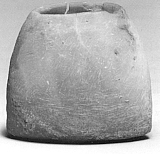
Alabaster miniature of a hide or cloth bag. Such bags were secured against unauthorized opening by the placement of a seal impression on the string closing the bag. From Susa, later fourth millennium.
Steve Zoraster has kindly called my attention to a possible parallel between the sealed sacks of precious metals and the practice of depositing accounting tokens made of clay or stone in round clay balls (bullae). The latter "envelopes" were sealed by the appropriate authorities with the seals sometimes including images of the tokens themselves. These sealed bullae are known from the later fourth millennium at Uruk and Susa.
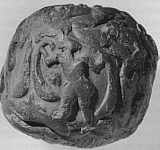
In the Amarna letters we find a reference to a "pot held in pledge" (Moran). Two linen sacks containing Hacksilber have been excavated at Ashkelon. They are dated to ca. 1100.
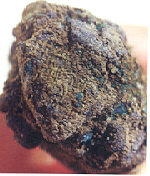 The evidence for Dor, a Mediterranean port just south of Haifa, is most impressive. In a clay jar buried in a pot beneath the floor of a building, archaeologists discovered the remains of some 17 linen bags filled with pieces of silver. Most of the silver is in the form "of small, flat tokens in the shape of small coins, as well as other pieces of cut silver ..." (Stern 1998: 50). Reportedly, each of the 17 units of silver, with relatively high gold content, weighs a bit more than a pound (490.5 grams). Each of the linen bags is, moreover, sealed with a bulla and the same same stamp seal was used to impress all the bullae.
The evidence for Dor, a Mediterranean port just south of Haifa, is most impressive. In a clay jar buried in a pot beneath the floor of a building, archaeologists discovered the remains of some 17 linen bags filled with pieces of silver. Most of the silver is in the form "of small, flat tokens in the shape of small coins, as well as other pieces of cut silver ..." (Stern 1998: 50). Reportedly, each of the 17 units of silver, with relatively high gold content, weighs a bit more than a pound (490.5 grams). Each of the linen bags is, moreover, sealed with a bulla and the same same stamp seal was used to impress all the bullae.  According to Stern (1998: 48): "The structure in which the vessel was found, located between two large buildings once associated with the harbor's maritime activities, dates to the late 11th or early 10th century B.C.E." On the other hand, the seal impressions consisting in interlocking scrolls and spiral designs has been dated on stylistic grounds to Middle Bronze II, about 1750 BCE. Stern (2001: 24-5) has also called attention to earlier finds of cloth-wrapped hoards at Megiddo (11th century) and Arad (10th century).
According to Stern (1998: 48): "The structure in which the vessel was found, located between two large buildings once associated with the harbor's maritime activities, dates to the late 11th or early 10th century B.C.E." On the other hand, the seal impressions consisting in interlocking scrolls and spiral designs has been dated on stylistic grounds to Middle Bronze II, about 1750 BCE. Stern (2001: 24-5) has also called attention to earlier finds of cloth-wrapped hoards at Megiddo (11th century) and Arad (10th century).
Sources: Ashkelon: King Philip J. and Lawrence E. Stager (2001). Life in Biblical Israel. Louisville: Westminster John Knox Press, 174-5; Dor: Stern, Ephraim. (1998). "Buried Treasure: The Silver Hoard from Dor." Biblical Archaeology Review, 24, 46-51, 62. Stern, Ephraim. (2001). "The Silver Hoard from Tel Dor." In Miriam Balmuth (ed.), Hacksilver to Coinage. New York: American Numismatic Society, 19-26. The Israel Museum, Jerusalem. (1997). New Antiquities: Recent Discoveries from Archaeological Excavations in Israel. Catalogue no. 402. Jerusalem: The Israel Museum, p. 16.
b. "Heads" as Coins ![]()
In the ANE and Greco-Roman world, "capital," or more specifically, "money" are meanings of words whose primary meaning is "head": Sumerian nig.ga; Akkadian qaqqadu = sag.du/sag and resisu (resu); Hebrew ro'sh; Demotic djadja; Egyptian tep; Greek kraros and kephale (kephalion); and Latin caput (kaput). Perhaps the identification of "head" with coin resulted from a practice, well known in the case of early Greek coins, of engraving coins with the head of a deity.
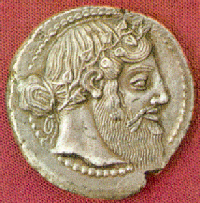
Dionysus on silver coin from Naxos, 5th century BCE
Mesopotamian commercial texts of the earlier second millennium and earlier first millennium refer to "heads of (the sun-god) Shamash" and to "heads of (the goddess) Ishtar." Earlier scholars including Olmstead (1930) reasoned that in Old Babylonian times:
The temple issued bits of metal, sometimes in long narrow bars and spits, like the later Greek obeliskoi, sometimes round like our modern coins. Their fineness was guaranteed by the temples, and in proof they were stamped with the head or figure of the god whose temple was the guarantor.For Ebla we have seemingly ordinary accounts of the delivery, consignment, disbursement as gifts of luxury goods including good dresses, jewelry, gold plate and the "head" of three named kings (see Archi).
c. "Loaves" as Coins
Assyrian loan contracts of the eighth to seventh centuries refer to a silver aklu "loaf" and a (c)huchuru "round loaf" that possess "the high degree of fineness of (the goddess) Ishtar" (Lipinski). (Texts of the fifteenth century from Alalakh also refer to the monetary "loaf" or "talent" [kakkaru].) Expressions of this kind refer to the quality of the metal and their inclusion in contracts is pointless unless the metal is impressed with a stamp of guarantee. It is plausible that the temple-issued "loaves" were "coins" accepted by the public without the necessity of tests of metal quality and, possibly, without weighing. Recall now the inscribed bread-shaped ingots discovered in Zinjirli (section 2).
See "Oedipus of Thebes as Coin-Loaf"
d. Documentary Evidence of Sealed Metals
In a strangely ignored note published in the 1989 issue of NABU, F. Joannès, basing himself on ARMT XXV, 815 and a letter to Zimri-Lim (A-486+), shows that Hammurabi paid/rewarded Mari's soldiers with (mysterious) shamshâtum "sun discs", gold rings, silver of 5 or 10 shekels, and small pieces of silver impressed with a seal. The key word here is kaniktum from kanâkum "to mark a seal." (Note also the term kâniktumpar "sheet/plate of sealed metal.") In the absence of (additional?) evidence for the use of kaniktum to make payments, Joannès suggests that these sealed silver objects may have been "medals." Of course, as this entire discussion should demonstrate there is ample evidence for coinage in Hammurabi's time and even earlier. Indeed, the evidence for coinage is far more ample than the evidence for "medals"! There is good reason for concluding that the kaniktum are coins. At the very least, the evidence demonstrates that the most ancient Near East had mastered the technology of sealing metals. Sealing a silver coin is no more difficult than sealing a silver medal.

4. Egypt
The evidence for an Egyptian coinage in very early times is even stronger than the Mesopotamian and, perhaps not surprisingly given the dominance of the "redistributional economy" perspective among Egyptologists, it is even less fashionable than a coinage interpretation of the "Shamash-heads."
To begin with, marketplace scenes from Old Kingdom mastabas depict traders with small linen sacks tied behind their shoulders. The sacks appear too small for carrying wares and thus may be money sacks (see Hodjash and Berlev).
Click here for full size image

More directly, in the second half of the second millennium we find prices expressed in terms of a unit variously written as shat/shaty/shenat/seniu. The words are written ideographically, concerning which more shortly, and conventionally translated as "piece." In the Old Kingdom the "piece" was determined by a lump of metal and later by the abstract determinative. The evidence strongly suggests that, at the very least, the reference is to a metal object of a given weight.
A text (Papyrus Brooklyn 35.1453A) of the 18th Dynasty records the delivery
of silver shatys to a woman at the meryet "quay, marketplace"
(Condon). In Papyrus Boulaq 11, probably of the 18th Dynasty, merchants pay for
quantities of meat and wine with shatys (Castle, Peet). On the other hand, the early Eighteenth Dynasty stela of Ahmose from Karnak transfers 1010 shat in the form of gold, silver, copper, grain and land (Logan 2000: 63). There is even an
inscription of the middle of the third millennium on the Giza monument that
quotes the price of a house in this monetary unit. The actual payment, however,
consisted of a bed and two types of linen cloth valued at four, three and two
shatys, respectively. More importantly, a marketplace scene of the middle
of the 5th Dynasty, depicted on the double tomb of two brothers, shows two
traders offering to exchange a roll of netjerew-fabric (linen) for a
djebawet "price" of six shat (Altermüller).* James
calls attention to the fact that "the purchaser is not shown with any reciprocal
object which he can trade against the cloth." There is little doubt that this a
cash transaction.
*For djeba see further TOPIC IV.2.
Visual evidence of the shat in circulation may perhaps be provided in a market scene of the thirteenth century from a tomb in Thebes. A man takes a container of beer or wine from a booth in exchange for two circular white objects. Glanville considers it "likely that they are enlarged representations of the shaty." Alternatively, the circular objects may represent copper coins (see below). Note the expression "busy as copper" in Papyrus Lansing (Topic I.F.2).
There is more that needs to be said about the previously mentioned quotation of the price of a house in an Old Kingdom transaction. The word shat in the Giza inscription was understood by several Egyptologists to be an early form of shawet or shayet "cakes" or "loaves." This, I believe, should be noted despite Peet's (unexplained) assertion that "the objections to this interpretation are very serious." The mention of "loaves" or "cakes" is made even more interesting because in Papyrus Boulaq (column 1, line 4) we find partial payment being made in shayet me kenken "beaten/crumbled cakes, making 1½ pieces [= shat]" (Peet). As noted above (section 3c) there are clear references to monetary "loaves" and "cakes" in Mesopotamian and Syrian texts.
Now we return to the ideographic writing of shat "piece." By the Middle Kingdom the ideograph included a distinctive sign that "we know very well from carefully made hieroglyphic examples ... represents a cylinder seal with a loop of string passed through the hole to suspend it by" (Peet; emphasis added). Again, in a mid-second millennium text (and elsewhere), the term shat arguably denotes the flat seal of a signet ring (djebat) (Castle). This connection is most significant because the seal is firmly linked to the known history of coinage in the Greek world. The Greek word sêma meaning "sign, token," has been found on coins of the seventh and sixth centuries BCE from the temple of Artemis in Ephesus: "This is the sêma of Phanes." Balmuth concludes that this is "the equivalent of a sealed piece of pre-weighed metal."
There is also some evidence of a copper coinage. In ca. 2000 Hekanakht (see Topic I.F.ADDITION) sent his agent "24 copper debens" for renting land. James explains that "the letter says quite clearly '24 copper debens', not '24 debens of copper', which ought to signify 24 pieces of copper each weighing one deben." Castle notes that "the primary lexical value of dbn appears to involve the concept of circularity" and, citing Weigall, he suggests that originally the word deben indicated a metal ring, "perhaps acquiring a fixed weight which later became a standard." It may be added that since reference is made only to the number of debens that they were of a standard metal quality as well as of a standard weight. That is, 24 copper coins.
Lastly, let us not omit mention of the Middle Kingdom Kahun papyri (II.1) wherein the purchaser of priestly office is quoted as having promised to turn over "the head (tep) and all 'assessments' ( fat wawa..." (Logan 2000: 59).
From an economic growth point of view the importance of the coin is that it reduces transaction costs by eliminating or reducing the costs resulting from tests of metal quality and weighing (?). The evidence summarized above strongly suggests that the transactional gains from guaranteed money, whether in the form of coins, loaf-shaped ingots, or tied sacks, were being reaped in the ANE as early as the third or second millennium.